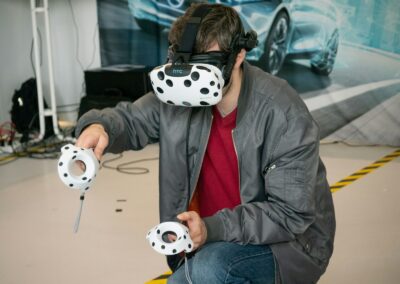Exploring the Innovations and Impact of Augmented Reality in Fitness
Introduction to AR Runner and Its Unique Features
The success of the AR sports training app, “AR Runner,” highlights the transformative potential of augmented reality (AR) in the fitness industry. Launched as an interactive running app, AR Runner uses augmented reality to create engaging and immersive running challenges that enhance the traditional fitness experience. The app leverages AR technology to overlay virtual checkpoints and challenges on real-world environments, motivating users to improve their performance through gamified elements.
The AR Runner app has gained significant traction in regions like Dubai and Riyadh, where there is a growing interest in integrating modern technology into fitness routines. Its success can be attributed to several key features, including real-time feedback, customizable challenges, and social sharing capabilities. By offering a unique blend of physical activity and digital interaction, AR Runner has managed to captivate a diverse user base ranging from casual runners to professional athletes.
One of the standout features of AR Runner is its ability to provide real-time feedback on user performance. This feature not only helps users track their progress but also encourages them to push their limits and achieve their fitness goals. Additionally, the app’s customizable challenges allow users to tailor their workouts to their specific needs and preferences, making it a versatile tool for fitness enthusiasts of all levels.
Engagement and Motivation Through Gamification
A critical factor behind the success of AR Runner is its effective use of gamification to boost user engagement and motivation. Gamification involves incorporating game-like elements into non-game contexts to enhance user experience and participation. In the case of AR Runner, gamification manifests through virtual checkpoints, leaderboards, and rewards that make running more enjoyable and competitive.
The app’s virtual checkpoints serve as milestones that users must reach during their runs. These checkpoints are strategically placed in the real world, guiding users along predefined routes and creating a sense of adventure. By turning a routine run into an interactive experience, AR Runner keeps users engaged and motivated to complete their workouts.
Leaderboards and rewards further enhance the competitive aspect of the app. Users can compare their performance with others in their local area or globally, fostering a sense of community and friendly rivalry. Rewards, such as badges and achievements, provide tangible goals for users to strive toward, adding an extra layer of motivation. This approach has proven particularly effective in tech-savvy cities like Riyadh and Dubai, where fitness enthusiasts are keen to embrace innovative ways to stay active.
Integration with Social Media and Community Building
Another key takeaway from the success of AR Runner is the importance of social media integration and community building in modern fitness apps. AR Runner allows users to share their achievements, routes, and challenges on various social media platforms, creating a sense of camaraderie and encouraging others to join the app. This social aspect is crucial for maintaining user interest and fostering a loyal community of fitness enthusiasts.
The ability to share personal fitness milestones and interact with other users adds a social dimension to the AR Runner experience. Users can follow their friends’ progress, participate in group challenges, and celebrate collective achievements. This community-driven approach not only enhances user retention but also attracts new users through word-of-mouth and social media exposure.
In regions like Saudi Arabia and the UAE, where social media usage is high, integrating social sharing features into fitness apps can significantly amplify their reach and impact. By creating a supportive and interactive community, AR Runner has managed to sustain user engagement and encourage a culture of active living.
Lessons for Developing Successful AR Fitness Apps
Prioritizing User Experience and Accessibility
The success of AR Runner underscores the importance of prioritizing user experience and accessibility in developing AR fitness apps. To provide a high-quality user experience, developers must focus on intuitive interface design, seamless navigation, and responsive performance. Ensuring that the app is accessible to a wide range of users, regardless of their technical proficiency or fitness level, is crucial for broadening its appeal.
Developers should also consider the diverse needs of users in different regions. For instance, incorporating features that cater to the unique fitness landscapes of Riyadh and Dubai can enhance user satisfaction and relevance. Providing localized content, such as region-specific challenges and culturally relevant themes, can make the app more engaging and relatable for users in these areas.
Leveraging Advanced Technology and Innovation
The innovative use of augmented reality is a significant driver behind AR Runner’s success. By leveraging advanced technology, the app offers an unparalleled fitness experience that blends the physical and digital worlds. Developers should continuously explore emerging technologies and trends to stay ahead in the competitive AR fitness market.
Incorporating AI-driven insights and personalized recommendations can further enhance the app’s value proposition. For example, AI algorithms can analyze user data to provide tailored workout plans, track progress, and suggest improvements. This level of personalization can significantly improve user satisfaction and outcomes.
Marketing and Community Engagement Strategies
Effective marketing and community engagement strategies are essential for the success of AR fitness apps. Developers should employ a multifaceted approach that includes digital marketing, influencer partnerships, and community events to promote the app and engage users. Highlighting success stories and testimonials from users in regions like Saudi Arabia and the UAE can build credibility and attract new users.
Creating opportunities for users to interact, share their experiences, and participate in challenges can foster a vibrant and supportive community. Regular updates, new features, and exclusive content can keep users excited and invested in the app. By building a strong community and maintaining consistent engagement, developers can ensure the long-term success of their AR fitness applications.
Conclusion: Embracing the Future of AR Fitness
The success of the AR sports training app “AR Runner” provides valuable insights into the potential of augmented reality in the fitness industry. By addressing technical challenges, leveraging gamification, and fostering community engagement, developers can create high-quality AR fitness apps that resonate with users. In dynamic regions like Riyadh and Dubai, where technology and fitness intersect, such innovations can significantly enhance the fitness experience and promote active lifestyles.
As the AR fitness landscape continues to evolve, developers must remain committed to innovation, user-centric design, and community-building efforts. By embracing these principles, they can unlock new opportunities and set new standards for excellence in the AR fitness domain.
—
#ARSportsTraining #ARRunnerApp #AugmentedRealityFitness #InteractiveRunningChallenges #ARSportsSuccess #DubaiARFitness #RiyadhARTraining #SaudiArabiaSportsTechnology























